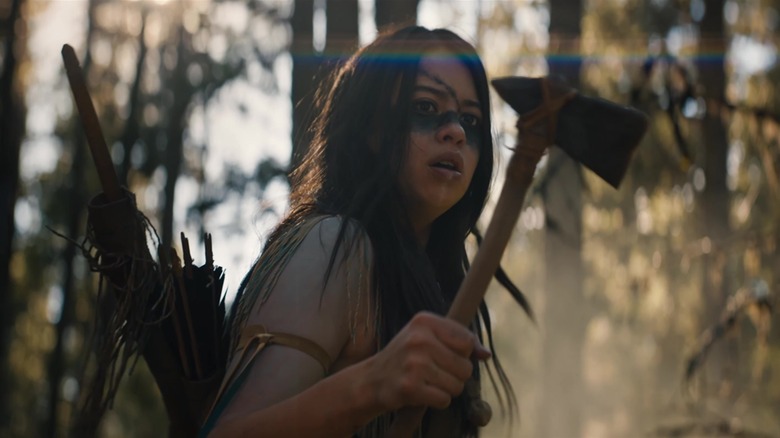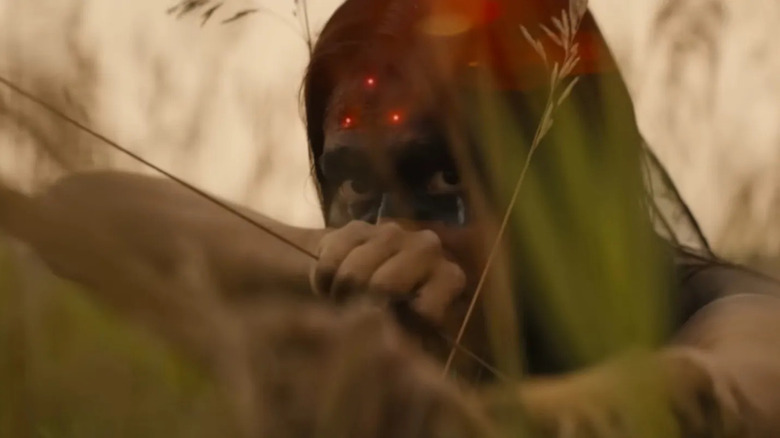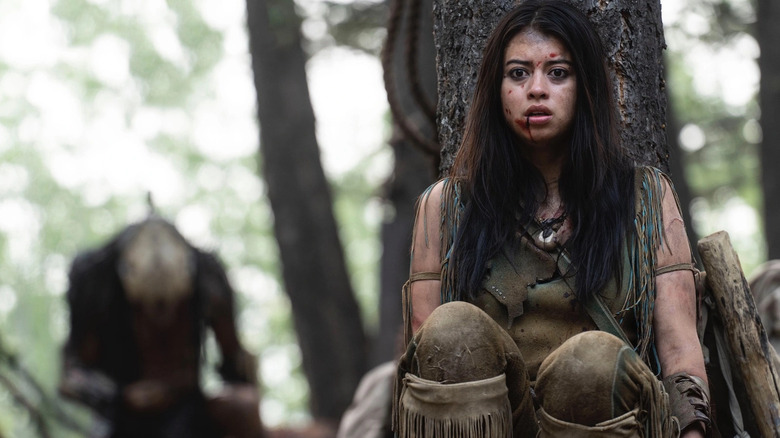Prey Feels Like A '90s Predator Comic – And That's A Good Thing
Those collecting comic books in the late '80s and early '90s likely recall the ascendency of Dark Horse Comics. Founded in Milwaukie, OR in 1986 by Mike Richardson, Dark Horse ran its own miniature staple of notable original characters like The Mask, Concrete, Barb Wire, Usagi Yojimo, and Hellboy. They were also the original publishers of Frank Miller's zeitgeist-rattling books "Sin City" and "300." An adaptation of Dark Horse's "Umbrella Academy" is still running on TV. The company first caught the public's attention, however, in 1987 through its varied character licensing deals, allowing them to make comics based on "Aliens," "Godzilla," "Star Wars," "RoboCop," "The Terminator," "Planet of the Apes," and, yes, "Predator."
Dark Horse's first "Predator" comics series was a straight adaptation of the John McTiernan movie and ran in 1989. This would kick off a long series of "Predator" comics stories that would run regularly throughout the 1990s. While most of the "Predator" comics were standalone stories, the titular hunt-happy aliens would often be seen battling other licensed characters in exciting/silly grudge matches. Predator vs. Batman, Predator vs. Judge Dredd, Predator vs. Tarzan, Predator vs. Archie. Stuff like that. In February of 1990, incidentally, in issue #36 of "Dark Horse Presents," Aliens and Predators did combat for the first time, whetting the imaginations of nerds everywhere, and eventually leading to two "Alien vs. Predator" movies.
Dark Horse, through their constant outpouring of "Predator" titles, ended up taking the franchise in more interesting directions than its feature films ever did, often coming up with interesting high concepts and seeing them through.
Dan Trachtenberg's new film "Prey," a prequel to the "Predator" movies, has way more in common with the "Predator" spinoff comics than any of the previous movies. And this is a very, very good thing.
Warning: spoilers for "Prey" follow.
Predators throughout history
Putting a Predator in the middle of various historical periods is a common feature of Dark Horse comics. "Predator: Hell Come Walkin'" (1998) was set during the Civil War, and the titular creature hunted both Confederate and Union soldiers. "Predator: Nemesis" (1997) took place in Victorian England, wherein the creature was nicknamed Springheeled Jack by the locals (look out for the Sherlock Holmes cameo!). "Predator 1718" (1996) takes place in that year and was set in the Caribbean, where the title monster could hunt pirates. Multiple "Predator" comics, meanwhile, take place in the distant future.
"Prey," true to the Dark Horse spirit of chronological innovation, takes place in 1719 in Comanche country, and makes wonderful use of its wilderness setting. "Prey" follows a young warrior named Naru (Sioux actress Amber Midthunder from "Legion") who is handy with a tomahawk and practices her own trademarked brand of tree parkour. As the film progresses, Naru finds mounting evidence that something deadlier than any animal might be lurking in the woods near her home. No one believes her at first, mistaking the invisible Predator's footprints for bear tracks. While she trails the Predator, the Predator trails snakes, wolves, bears, and even humans, as it seems to be seeking Earth's most dangerous game. It's a mercifully paced film that cares to establish character and atmosphere ahead of mayhem and cutesy references to previous films in the franchise (although they can't resist including the line "If it bleeds, we can kill it").
The limits of Predators
An issue that any long-running film series is going to run into will be the audience's eventual familiarity with the material. In 1979, the events of Ridley Scott's "Alien" must have seemed quite a surprise. What are those eggs? What is that thing on John Hurt's face? What is it doing? What is the nature of the monster that exploded out of his abdomen? The mechanics of Alien reproduction could be slowly discovered by a rapt audience. By the time audiences came to "Alien vs. Predator," the creatures would go from being face-huggers to full-grown xenomorphs in the span of maybe 30 minutes. As the audience no longer needed to be walked through the process, the screenwriters felt free to rush things.
The simplicity of the "Predator" movies is both a strength and a weakness: A seemingly unstoppable monster is hunting humans who, no matter how well-armed or how well-trailed militarily, are going to be killed. There's not much to expand from. The efficiency of the Predator ethos makes for vast limitations. A good Predator story, then, needs a hook. A gimmick. Something to make it look and feel unique from all the other Predator stories. The Predator either needs interesting prey to hunt or needs to hunt in an interesting timeframe or location. Dark Horse certainly knew this.
"Prey" provides both a good hero and a good locale. Naru is an intelligent character capable of facing a Predator, and she has no modern weaponry to rely on. The creature will be faced with arrows, tomahawks, and gumption. And seeing a Predator face off against both Comanches and the occasional French trapper is surely somewhere the films have never gone before.
Finally, with "Prey," the Predator movies are as interesting as the comics.


